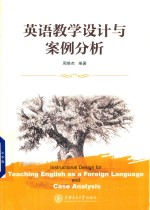
- 作 者:周维杰编著
- 出 版 社:上海:上海交通大学出版社
- 出版年份:2018
- ISBN:9787313194350
- 标注页数:144 页
- PDF页数:165 页
请阅读订购服务说明与试读!
订购服务说明
1、本站所有的书默认都是PDF格式,该格式图书只能阅读和打印,不能再次编辑。
2、除分上下册或者多册的情况下,一般PDF页数一定要大于标注页数才建议下单购买。【本资源165 ≥144页】
图书下载及付费说明
1、所有的电子图书为PDF格式,支持电脑、手机、平板等各类电子设备阅读;可以任意拷贝文件到不同的阅读设备里进行阅读。
2、电子图书在提交订单后一般半小时内处理完成,最晚48小时内处理完成。(非工作日购买会延迟)
3、所有的电子图书都是原书直接扫描方式制作而成。
Part One Instructional Design of Reading and Case Analysis 1
Case 1 Theme-based Instructional Design of Parental Love and Analysis 1
Ⅰ.Theme-based Instructional Design of Parental Love 1
Step 1:Lead-in with a questionnaire about parental love 1
Step 2:Reading with a focus on how to show parental love through what they said 2
Step 3:Reading with a focus on how to show parental love through what they did 2
Step 4:Reading with a focus on how to show parental love through what they thought 4
Step 5:Reading with a focus on the most-used way and the least-used way to show parental love in the four texts 5
Step 6:Summarization of parental love in the four texts 5
Step 7:Gratitude for parental love by singing the song East or west,Mama is the best 5
Step 8:Assignment:Reading Mother with feelings 6
Ⅱ.Analysis 8
Ⅲ.Full Texts 9
Case 2 Instructional Design of Storytellers from the Perspective of Education and Analysis 19
Ⅰ.Instructional Design of Storytellers from the Perspective of Education 19
Step 1:Lead-in with a discussion on the questions about a better education 19
Step 2:Close reading with a focus on Mo Yan’s moral education 19
Step 3:Close reading with a focus on Mo Yan’s intellectual education 22
Step 4:Close reading with a focus on Mo Yan’s physical education 24
Step 5:Extended reading with a focus on tranquility education 24
Ⅱ.Analysis 26
Ⅲ.Full Text 27
Case 3 Instructional Design of The Bible Stories Based on 3R and Analysis 36
Ⅰ.Instructional Design of The Bible Stories Based on 3R 36
Step 1:Lead-in with a brief introduction to the Bible 36
Step 2:Reading the lines with a focus on factual questions 36
Step 3:Reading between the lines with a focus on inference questions 37
Step 4:Reading beyond the lines with a focus on association questions 42
Step 5:Assignment:Reading more Bible stories after class 43
Ⅱ.Analysis 43
Ⅲ.Full Texts 44
Case 4 Instructional Design of Getting the Best Value for Time under Question-based Approach and Analysis 51
Ⅰ.Instructional Design of Getting the Best Value for Time under Question-based Approach 51
Step 1:Brief introduction to this course and course requirements 51
Step 2:Lead-in with the question about the differences between learning at high school and learning at college or university 52
Step 3:Skimming with a focus on the questions about the organization of the text 52
Step 4:Close reading with a focus on the question about the writing quality of each part 53
Step 5:Close reading with a focus on the question about reorganization and recombination of the text 53
Step 6:Discussion of the questions about the title 54
Step 7:Discussion of the questions about the text substantiation 54
Ⅱ.Analysis 54
Ⅲ.Full Text 55
Case 5 Instructional Design of Steve Jobs’Speech at Stanford Commencement Based on Annotative Response Writing and Analysis 56
Ⅰ.Instructional Design of Steve Jobs’Speech at Stanford Commencement Based on Annotative Response Writing 56
Step 1:Lead-in with a brief introduction to annotative response writing 56
Step 2:Annotative response writing with a focus on association 57
Step 3:Annotative response writing with a focus on comments 57
Step 4:Annotative response writing with a focus on understanding 58
Step 5:Annotative response writing with a focus on interpretation 58
Step 6:Assignment with a focus on choice and voice of favorite sentences 58
Ⅱ.Analysis 58
Ⅲ.Full Text with Annotative Response Writing 59
Case 6 Interaction-based Instructional Design of Horoscopes and Analysis 69
Ⅰ.Interaction-based Instructional Design of Horoscopes 69
Step 1:Lead-in with a video about the Chinese Zodiac 69
Step 2:Reading with a focus on the interaction between students and the text about horoscopes 70
Step 3:Reading with a focus on the interaction between students and students about horoscopes 71
Step 4:Reading with a focus on the interaction between students and teacher about horoscopes 72
Step 5:Assignment with a focus on your opinions about horoscopes 72
Ⅱ.Analysis 73
Ⅲ.Full Text 73
Case 7 Instructional Design of l(a Based on"From-Within-the-Text-to-Beyond-the-Text Reading"and Analysis 76
Ⅰ.Instructional Design of l(a Based on"From-Within-the-Text-to-Beyond-the-Text Reading" 76
Step 1:Lead-in with a brief introduction to e. e. cummings 76
Step 2:Within-the-text reading with a focus on the image 77
Step 3:Within-the-text reading with a focus on the theme 78
Step 4:Beyond-the-text reading with a focus on the image 79
Step 5:Beyond-the-text reading with a focus on the theme 81
Ⅱ.Analysis 82
Case 8 Instructional Design of Genealogy of Deities in Greek Mythology Based on Mind Map and Analysis 83
Ⅰ.Instructional Design of Genealogy of Deities in Greek Mythology Based on Mind Map 83
Step 1:Lead-in with a focus on the characteristics of Greek mythology 83
Step 2:Learning with a focus on Chaos:primeval state of existence 83
Step 3:Learning with a focus on Uranus-Gaea:the first-generation deities 84
Step 4:Learning with a focus on Cronus-Rhea:the second-generation deities 85
Step 5:Learning with a focus on Zeus-Hera:the third-generation deities 85
Step 6:Assignment:Exploring 10 idioms originating from Greek Mythology 87
Ⅱ.Analysis 87
Part Two Instructional Design of Lexicology and Case Analysis 88
Case 9 Instructional Design of A Mastery of 3,000 Words Within 100 Days Based on 3S and Analysis 88
Ⅰ.Instructional Design of A Mastery of 3,000 Words Within 100 Days Based on 3S 88
Step 1:Lead-in with three personal memorization experiences 88
Step 2:A mastery of 3,000 words within 100 days based on sound 89
Step 3:A mastery of 3,000 words within 100 days based on shape 90
Step 4:A mastery of 3,000 words within 100 days based on sense 91
Step 5:Assignment:Reading Words and Their Stories about money 94
Ⅱ.Analysis 96
Case 10 Instructional Design of Characteristics of Affixes Based on One-with-many Pattern and Analysis 96
Ⅰ.Instructional Design of Characteristics of Affixes Based on One-with-many Pattern 96
Step 1:Lead-in with many affixes with one meaning 96
Step 2:Characteristics of affixes with a focus on one affix with many meanings 96
Step 3:Characteristics of affixes with a focus on one affix with many parts of speech 97
Step 4:Characteristics of affixes with a focus on one affix with many forms 98
Step 5:Characteristics of affixes with a focus on one affix with many sources 98
Step 6:Characteristics of affixes with a focus on one affix with many positions 98
Step 7:Characteristics of affixes with a focus on one affix with many categories 99
Ⅱ.Analysis 99
Case 11 Instructional Design of Semantic Field Based on 3C and Analysis 99
Ⅰ.Instructional Design of Semantic Field Based on 3C 99
Step 1:Lead-in with a brief introduction to the origin of field 99
Step 2:The teaching of Semantic Field with a focus on the first C:Concept 100
Step 3:The teaching of Semantic Field with a focus on the second C:Categorization 100
Step 4:The teaching of Semantic Field with a focus on the third C:Characteristics 103
Step 5:Assignment:Reading We Need More with a focus on antonymous semantic field 104
Ⅱ.Analysis 105
Part Three Instructional Design of Translation and Case Analysis 106
Case 12 Instructional Design of Inversion Based on System Theory and Analysis 106
Ⅰ.Instructional Design of Inversion Based on System Theory 106
Step 1:Lead-in with a brief introduction to translation techniques with inversion as a focus 106
Step 2:Inversion in the coordinate structure without any restraint from the original 107
Step 3:Inversion in terms of logical relationship 108
Step 4:Inversion in terms of adverbials 110
Step 5:Inversion in terms of attributes 111
Ⅱ.Analysis 112
Case 13 Instructional Design of Strategies for English-to-Chinese Transliteration from Phonological Perspective and Analysis 113
Ⅰ.Instructional Design of Strategies for English-to-Chinese Transliteration from Phonological Perspective 113
Step 1:Lead-in with three phonological rules 113
Step 2:Epenthesis strategies for English-to-Chinese transliteration 115
Step 3:Segmental adaptation strategies for English-to-Chinese transliteration 117
Step 4:Deletion strategies for English-to-Chinese transliteration 118
Step 5:Segmental split strategies for English-to-Chinese transliteration 119
Ⅱ.Analysis 120
Part Four Instructional Design of Research Methods and Case Analysis 121
Case 14 Inquiry-based Instructional Design of Definition of Research and Analysis 121
Ⅰ.Inquiry-based Instructional Design of Definition of Research 121
Step 1:Inquiry into Definition of Research in terms of“研” 121
Step 2:Inquiry into Definition of Research in terms of“究” 122
Step 3:Inquiry into Definition of Research in terms of"re-" 123
Step 4:Inquiry into Definition of Research in terms of"search" 123
Step 5:Inquiry into Definition of Research in terms of“研究” 126
Step 6:Inquiry into Definition of Research in terms of“research” 126
Step 7:Zhou’s definition of research upon the previous definitions 127
Ⅱ.Analysis 128
Case 15 Methodology-based Instructional design of Three Issues Concerning Research Methods in Applied Linguistics and Analysis 128
Ⅰ.Methodology-based Instructional design of Three Issues Concerning Research Methods in Applied Linguistics 128
Step 1:Lead-in with two short stories about different views about the same thing 128
Step 2:The first issue concerning research methods:research process 130
Step 3:The second issue concerning research methods:the same research question leading to different conclusions because of different methods 132
Step 4:The third issue concerning research methods:no perfect research method 136
Step 5:Assignment with a preview of Variables 136
Ⅱ.Analysis 136
Part Five Instructional Design of Linguistics and Case Analysis 137
Case 16 Instructional Design of Linguistics Based on Arousal of Students’ Interest and Analysis 137
Ⅰ.Instructional Design of Linguistics Based on Arousal of Students’Interest 137
Step 1:Lead-in with some interesting episodes in Linguistics 137
Step 2:Arousing students’interest in linguistics in terms of sound 138
Step 3:Arousing students’interest in linguistics in terms of form 139
Step 4:Arousing students’interest in linguistics in terms of meaning 140
Step 5:Arousing students’interest in linguistics in terms of sound,form and meaning 142
Step 6:Assignment:Reading a short passage about Crazy English 142
Ⅱ.Analysis 143
参考文献 144
